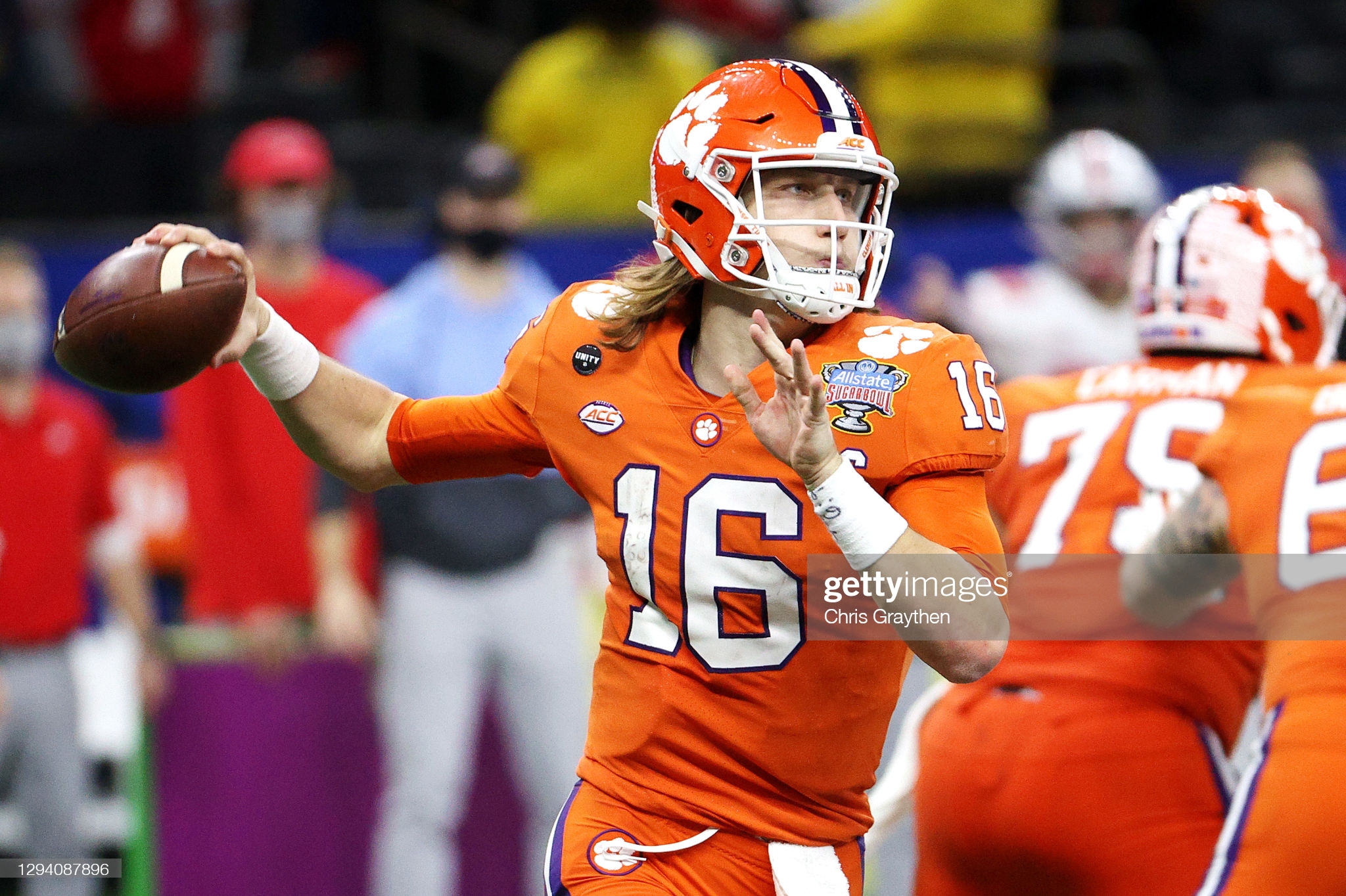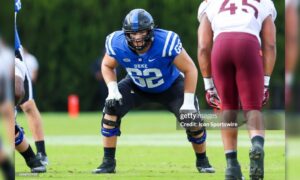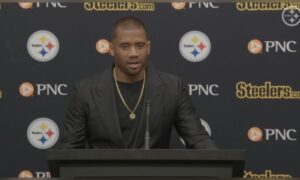Every year, I save my first and only mock draft for the week of the big event. Much of the dust has settled, trades are at a standstill, and if there are rumors that can affect picks, they’re out there by now.
So here is my 2021 edition, beginning with the obvious at No. 1 and running through a sliding player being caught by the Super Bowl champions at No. 32. My main rule is that I do not project trades, which makes it harder to retain accuracy going through the round as big jumps ruin what was projected to happen.
The last two seasons, I have hit on eight of the 32 picks. This year, the goal is double digits.
1. Jacksonville Jaguars: Trevor Lawrence, QB, Clemson
There is no question here. Just like the Indianapolis Colts (twice) before them, the Jaguars inherit the good fortune of finishing worst the year a potential generational QB talent is in the draft pool. Now its up to Lawrence to become the face of the Jacksonville Jaguars, something at quarterback it’s arguable to say they’ve never truly had.
2. New York Jets: Zach Wilson, QB, BYU
The big question isn’t whether Wilson will be the pick here or not — that seems pretty set in stone. The big question is whether Wilson can survive the baptism by fire that engulfed the careers of Sam Darnold, Mark Sanchez, and Geno Smith — both on the field and in a huge media market. I like his odds, but it’s a tall task. New York dealt Darnold — they’re ready to name the next great new hope for the franchise.
3. San Francisco 49ers (from Houston via Miami): Mac Jones, QB, Alabama
The draft begins at No. 3, where everyone knows San Francisco moved up to get their franchise QB, but no one knows which one it is, exactly. My pick? Justin Fields. Who I think fits what Kyle Shanahan likes to do best? Trey Lance. So let’s ignore both of those and say that the name most believe it to be is correct. Jones proved many of his detractors wrong this season and during the Senior Bowl and pre-draft process. Whichever of the three QBs remaining it is, the 49ers will set up as best they can for success.
4. Atlanta Falcons: Kyle Pitts, TE, Florida
There’s needs at a lot more than just tight end for Atlanta, and the Falcons should strongly consider drafting Georgia native Justin Fields here to be the next era of the franchise. That Matt Ryan contract is an albatross, and forces the Falcons to try and win with him until they can get out from under it. Pitts helps them do that, as a truly elite TE prospect, one of the best ever to come out of the college ranks.
5. Cincinnati Bengals: Ja’Marr Chase, WR, LSU
For the sake of Joe Burrow, this pick should be a tackle without a second thought to the contrary. Cincinnati signed Riley Reiff though to protect Burrow, and the Bengals’ second-year QB has advocated to bring his favorite college target to Cincy. Drafting Chase gives the QB what he wants, reunites an incredible collegiate duo, and creates one of the best young WR trios in the NFL with Tee Higgins and Tyler Boyd. Starting tackles will be available at the Bengals’ second-round pick.
6. Miami Dolphins (from Philadelphia): DeVonta Smith, WR, Alabama
The Dolphins have begun to improve the offense around Tua Tagovaila, but free agent signing Will Fuller’s deal is only for one season. Drafting the Heisman Trophy winner and one of the best receivers in recent college history gives Tua not only one of his former teammates to throw to, but a true No. 1 target who is with him long-term. Concerns about Smith’s weight will never go away, but the way he produced in college should overcome those fears. Strongly considered Penei Sewell here, after the Ereck Flowers trade with Washington.
7. Detroit Lions: Jaylen Waddle, WR, Alabama
This comes down to Jaylen Waddle, Penei Sewell, and Micah Parsons, all three major needs for the Lions. Detroit just watched star Kenny Golladay leave for New York, and is currently starting some combination of Breshad Perriman and Tyrell Williams. Waddle has speed to burn, and gives the Lions a top WR for Jared Goff now, and for a potential first-round pick in the next couple drafts in the future.
8. Carolina Panthers: Penei Sewell, OT, Oregon
Quarterback may be tempting, but I believe the Panthers brought in Sam Darnold to try to make something of him. He has receivers in DJ Moore and Robby Anderson, but what he needs is a blue chip left tackle to keep him upright. Sewell has retained his status as the top tackle in the class for a full year, despite opting out of the 2020 season. He gets to play on the left side where he belongs, and represents some value this late in the top 10 for Matt Rhule.
9. Denver Broncos: Justin Fields, QB, Ohio State
I could see either Fields or Trey Lance being a fit for the Broncos. But after taking on a bit of a developmental project in Drew Lock and getting less-than-ideal results, I’m not sure Denver wants to go back to that well with Lance. Fields is closer to NFL-ready, with one of the best deep balls in the class and the attitude and toughness to succeed in this league. He will need some work early, but imagining Fields with the array of weapons Denver has assembled the last few drafts is exciting.
NOTE: This draft was filed prior to Denver trading for Carolina QB Teddy Bridgewater, because why not do a draft-altering deal like that as writers everywhere file their final mocks.
10. Dallas Cowboys: Patrick Surtain II, CB, Alabama
The pick is likely cornerback with how much improvement the Cowboys’ secondary needs. The question is which one, with the entire pool of them still available here. Surtain can immediately step in to one of the two spots along the outside, and pair with Trevon Diggs to create an all-Alabama tandem for Dallas. After hitting on Diggs, the Cowboys may have a preference for another Alabama corner vs. another school.
11. New York Giants: Micah Parsons, LB, Penn State
New York hasn’t been shy in using free agency to fill holes on the depth chart. One of the most glaring ones left is in the middle of the team’s defense, where the team lacks a big-time starter to play between a young defensive line and much-improved secondary. Parsons is an unreal athlete for the position, and can fill one of any of the open linebacking spots the Giants have.
12. Philadelphia Eagles (from San Francisco via Miami): Jaycee Horn, CB, South Carolina
Now committed to a new era under Jalen Hurts, Philadelphia needs outside players on both sides of the ball. With the top three receivers long gone by this point, the Eagles take Horn, one of the best athletes by Relative Athletic Score to ever come out of college at the CB position. The South Carolina man pairs with Darius Slay to turn the secondary into a strength for the team.
13. Los Angeles Chargers: Rashawn Slater, OT, Northwestern
The Chargers found their franchise face in Justin Herbert, and invested in Corey Linsley and Matt Feiler to protect him. Now, the team finds a tackle to become Herbert’s blindside wall for the forseeable future. Slater comes with questions about his smaller size compared to typical tackles, but his college tape showed somebody who can play at the NFL level without needing to kick inside.
14. Minnesota Vikings: Christian Darrisaw, OT, Virginia Tech
The Vikings have repeatedly invested in their offensive line in recent drafts, but still have holes to fill, particularly after releasing Riley Reiff this offseason. Darrisaw immediately steps in and fills the vacated spot left by Reiff at left tackle, and becomes the key player on Minnesota’s young offensive line. Alijah Vera-Tucker can’t be discounted here, either, as someone who can be played at tackle of guard.
15. New England Patriots: Trey Lance, QB, North Dakota State
In reality if a QB (particularly Justin Fields) begins to slide, I would be shocked if Bill Belichick didn’t move up to get him before this. But banning myself from mocking any trades, the Patriots still get their next franchise QB. It’s just Lance, instead of Fields. He shouldn’t be asked to contribute much as a rookie, and gets a season to learn under another athletic QB in Cam Newton before being introduced as the starter and face of the post-Tom Brady era. The questions are how New England adapts its offense to best utilize the athleticism Lance brings to the position, and how they can develop the most raw QB of the five expected to go in the first round this year.
16. Arizona Cardinals: Caleb Farley, CB, Virginia Tech
Someone has to take a chance on Farley early in this draft, and I think Arizona could be that team. The Cardinals have to replace Patrick Peterson on the outside corner, and no one rookie can be expected to do all the Cards’ franchise icon did. Farley, if healthy, comes as close to doing so as any corner in this class. The key issue this pick hinges on is Farley’s medical reports, and how Arizona feels about his health and ability to stay healthy in the NFL. Farley was a contender to be the top corner in the class pre-back surgery, and that ceiling is still there. I strongly considered a surprise of Asante Samuel Jr. here.
17. Las Vegas Raiders: Jeremiah Owusu-Koramoah, LB/S, Notre Dame
Good luck predicting how the Raiders select, given their unqieu system of valuing players that has resulted in Clelin Ferrell going fourth overall and Damon Arnette 19th. Vegas could go any number of directions based on needs along the offensive line and on defense. Both linebacker and safety are areas to improve upon, and Owusu-Koramoah is capable of helping at both. He is athletic enough to play in coverage and handle more of a linebacking role, and Vegas has already begun working with a player like that in previous first-rounder Jonathan Abram, who can’t stay healthy.
18. Miami Dolphins: Teven Jenkins, OT, Oklahoma State
I almost pulled the trigger on a tackle at six, but I’m going for it here. Edge rusher is absolutely a need, but with none off the board Miami will have one available in the second. The same can’t be said for tackles, of which Jenkins is the best one remaining and the last likely lock for the first round. The Oklahoma State mauler gets to stay on the right side where he is better suited, and provides insurance in case 2020 first-rounder Austin Jackson fails to develop after a rough rookie season.
19. Washington Football Team: Zaven Collins, LB, Tulsa
Collins is listed as a linebacker here because that’s more of the role he would fill for Washington early on, but it could also say EDGE depending on the team that drafts him. Collins brings the versatility to play as more of an inside linebacker and as more of an edge rusher depending on the situation, and his production at a smaller school speaks for itself. Washington desperately needs linebackers, inside and edge, moreso than the several other weaknesses on the roster.
20. Chicago Bears: Alijah Vera-Tucker, OL, USC
Chicago has found success in drafting offensive linemen who could play multiple positions on the line. Starting linemen James Daniels and Cody Whitehair both were drafted as players who could play guard or center. The Bears return to the well here to get another player like that in Vera-Tucker. Vera-Tucker played tackle at USC, but his size better profiles as a guard in the NFL. The Bears can play him at either spot or as a backup lineman his rookie season, and figure out where he plays best as the team reloads to try and find its QB of the future next offseason.
21. Indianapolis Colts: Jaelan Phillips, EDGE, Miami (FL)
If Indianapolis goes offense early, it’s to get some more blocking for new QB Carson Wentz. With every surefire first-round tackle gone, the pick pivots to defense, where no need is greater than that of a pass rusher. This class is weak at the position, with Philips representing one of the top couple names. He should immediately unseat either Tyquan Lewis or Al-Quadin Muhammad for a spot at end.
22. Tennessee Titans: Elijah Moore, WR, Ole Miss
Tennessee has its star, A.J. Brown, a mammoth of a receiver and one of the best young targets in the game. Losing its second and third options to free agency leaves pass catcher once again a need for the franchise, as it looks to maximize its window with Ryan Tannehill as the starter. Moore provides a compliment to Brown, being a smaller-bodied, speed threat who can be a slot dynamo while Brown handles the outside and sidelines.
23. New York Jets (from Seattle): Greg Newsome II, CB, Northwestern
It’s easier to name the spots New York won’t consider here rather than those in play. Anywhere on defense and all but QB and WR on offense could be the selection depending on how the board falls. A top running back and edge rusher will make it to their slot in the early second, but a cornerback worth that pick may not. Newsome shot up draft boards with his Pro Day performance, and will immediately slot in near the top of a ragged CB depth chart.
24. Pittsburgh Steelers: Najee Harris, RB, Alabama
The only things stopping the Steelers from taking Harris are a top lineman falling to them and a player taking a big slide down to 24. Neither happens here, so the Steelers become the latest franchise to go against the grain with a first-round RB, whom they have coveted for some time. Harris fits what the Steelers want perfectly, and jumps in as a focal point of the offense on his first day.
25. Jacksonville Jaguars (from the Los Angeles Rams): Trevon Moehrig, S, TCU
Years of drafting for offense have left the Jaguars with only a couple needs there, and allow them to focus their second first-round pick on defense, where needs abound. Bringing in Shaquill Griffin to play corner shortly after drafting C.J. Henderson to do the same, the Jags have built a new secondary, but need a safety to help lead it. Enter Moehrig, the best name in a class weak on top-end talent but strong in depth. His ball skills in coverage and aggressiveness attacking downhill fit right at home with what Jacksonville is building defensively.
26. Cleveland Browns: Azeez Ojulari, EDGE, Georgia
The Browns finally got their man when they lured Jadeveon Clowney in with a one-year deal. But the team still has a weak group of linebackers behind its strong defensive line, and Ojulari helps address that. More of an edge rusher than a traditional linebacker in the box, Ojulari can still push for playing time as a rookie, while learning from Myles Garrett and Clowney before inheriting Clowney’s role as the primary edge rusher opposite Garrett following this season.
27. Baltimore Ravens: Rashod Bateman, WR, Minnesota
I noticed Kwity Paye sitting there for Baltimore, but with receivers potentially going the next two picks before the Ravens are up again, they pull the trigger on a new No. 1 here. Bateman with his speed (4.39 40) is the next in line of late-first receiver picks for the Ravens as they try to find one who sticks as the main target, and he should compete with former first-rounder Marquise Brown and free agent signing Sammy Watkins to be the main target for Lamar Jackson.
28. New Orleans Saints: Nick Bolton, LB, Missouri
With the offense the Saints still have even after losing Drew Brees, this pick has to address the defense, and the loss of either linebacker Kwon Alexander or corner Janoris Jenkins. Bolton is a plug-and-play linebacker who really popped on film from the 2020 season, stealing your eyes away from other players. He would be right at home in the middle of the Saints’ defense, and getting to learn from Demario Davis is a definite incentive to making this selection. New Orleans can address corner on Day 2, with more still on the board than at LB.
29. Green Bay Packers: Creed Humphrey, C, Oklahoma
Once again, a receiver for Aaron Rodgers is far from a slam dunk in the first, despite another historically good class. Linebacker and edge rusher could steal away the pick, as could my selection here. Losing Corey Linsley leaves a hole in the middle of Green Bay’s line, and the Packers may not want to fill it with Lucas Patrick or move Elgton Jenkins from guard. Humphrey is the best athlete ever at his position by RAS, and the Packers can put him in at starter without a second thought to protect Rodgers and newly-extended RB Aaron Jones. I considered Landon Dickerson here, but his medicals are too scary to buy into many teams pulling the trigger in the first round.
30. Buffalo Bills: Travis Etienne, RB, Clemson
The Bills covet a running back to step in and become the threat Devin Singletary and Zack Moss have failed to be, and with one of their two preferences gone at pick 24, they select the other (and potentially their preferred name) at 30. Etienne supplants both those players as the Bills’ primary backfield threat, and should do away with the days of RB by committee that have plagued the offense in the Josh Allen era.
31. Baltimore Ravens (from Kansas City): Landon Dickerson, C, Alabama
There is a Matt Skura-sized hole in the Ravens’ offensive line that hasn’t existed for almost a half-decade. With other teams lurking to begin snapping up the other centers in the second (the Ravens don’t pick again until the later third), Baltimore bypasses Paye and the other edge rushers again for Dickerson, the draft’s top center and a much higher pick without the medical red flags. Baltimore seems like one of the teams more willing to take a chance on Dickerson if they’re alright with what they see from his medicals, and he fits the identity and mentality of the team well.
32. Tampa Bay Buccaneers: Kwity Paye, EDGE, Michigan
Retaining an entire team after winning the Super Bowl is simply unfair, and some truly phenomenal work by GM Jason Licht. It also lets Tampa Bay go purely by best player available during the draft, with no immediate needs. There are some developing ones on defense at every level, though, and the Bucs address one by snagging the freefalling Paye, who many believe to be the best edge rusher in the class. His production was lacking at Michigan, but with no need to rush him into the starting lineup, Tampa can let Paye develop and reach his ceiling as a rookie under the tutelage of Jason Pierre-Paul and Ndamukong Suh. The line has suffered its share of injuries, so there’s opportunity for Paye to see some significant snaps, too.








